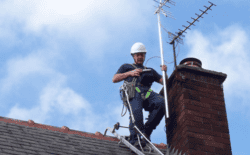The weather can adversely affect your TV aerial and the quality of your television signal if it goes to extremes. This can be frustrating if you are in the middle of watching an exciting show; however, standard British weather doesn’t usually cause too many problems.
Can rain affect the signal?
Light rain won’t usually have a huge impact on your television reception; however, heavy bouts of rain or thunderstorms can disrupt the signal, leading to an interruption in viewing.
Will wind have an impact?
Strong winds can cause your TV aerial to move, altering the alignment and direction. This can result in a weaker signal or even a complete loss. If your aerial is mounted on your roof, high winds can cause the aerial to move or even break.
Can fog and mist weaken the signal?
Fog and mist can lead to a loss in signal strength, especially in areas where the signal is already weak. It is actually the moisture in the air that affects the TV signal waves.
How will snow and ice impact the signal?
Snow will generally not affect your signal too much; however, heavy snowfall can build up on the aerial, causing a loss in signal. Ice accumulating on the aerial can also result in misalignment or damage. The weight of the ice can also cause the aerial to shift from its position.
If you have a signal issue and you require TV aerial repair Bristol, companies such as aerial-installations-bristol.co.uk have the expertise to resolve the issue.
Do people still need television aerials?
In the age of streaming, the good news is that aerials have not reduced in popularity; in fact, with many people looking to save cash, ditching streaming in favour of standard television services is becoming more common.
How will lightning or thunderstorms affect the aerial?
Thunderstorms accompanied by lightning strikes can pose a risk to your TV aerial and other electronic equipment. A lightning strike near your TV antenna can damage it or even cause a power surge that will affect connected devices.



